RAPID+TCT 2023 has officially wrapped, with the final day of the largest 3D printing event in North America highlighting a number of new machines, softwares, and material offerings. Read our round-up of RAPID day one and RAPID day two for all the news from Chicago.
As with the first two days, Todd Grimm, Founder and President of T.A Grimm & Associates. Inc., was first to take to the main stage. Grimm gave a succinct run down on the key highlights and new offerings to look out for on day 3 of Rapid + TCT 2023, “to help fine tune the remaining hours we have”.
First up was AON3D’s new software offering, which is focused on 3D printing high temperature materials. The Montreal based company offered a sneak preview of this new machine learning-driven thermal optimization software, which is a core technology simulation engine developed specifically for Material Extrusion (MEX). Said to enable cost-cutting, improved part reliability and consistency, the company has also announced that it will also be accepting clients for beta testing.
Grimm also highlighted 3DXTECH’s new Gearbox HT2 High Temp 3D printer. Grimm reported that he was “shocked to learn” that this is an entry level machine, with an actively heated chamber reaching up to 250℃, and a substantial build volume of 18 x 18 x 32 inches being available for an affordable price. The company is now taking orders for this new machine, and is offering relatively short lead times of only two weeks.
On day one of the event we covered Ulendo’s vibration compensation software, which the company claims can “double the throughput of 3D printers.” Grimm today pointed to this offering as being particularly noteworthy, calling it a “simply elegant” system.
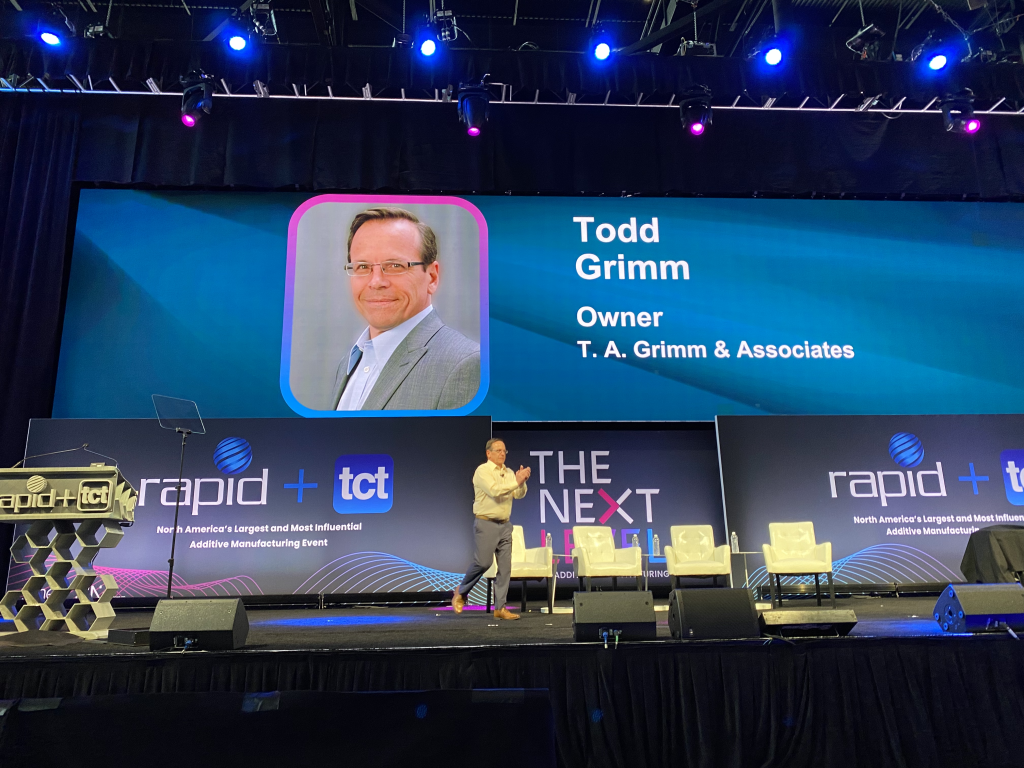
3D Printing Industry also had the opportunity to speak with Grimm on day three. He highlighted two key themes at this year’s event. First, the continuation of “innovative solutions, growth and expansion” within the industry. “We haven’t seen the innovation dry out,” says Grimm, creating “a lot of momentum going forward.” Additionally, “the real need for solutions” has backstopped this growth, with Grimm also outlining “the pragmatic development as a response to user demands” as being what will get Additive Manufacturing to the next stage.
Also notable about this year’s event is the exception of Carbon and Desktop Metal, two big hitters within Additive Manufacturing. Whilst Grimm could only speculate on the reasons behind this, he pointed to factors such as perceived over-promising and under-delivering, and the financial implications of this, as potentially having an impact on their decision not to attend this year’s event.
The opportunities and challenges within the current Additive industry
Unlike the keynote’s of the past two days, the final day saw a panel discussion on the main stage. Moderated by SME Director and CEO Robert Willig, the panel also included Terry Wohlers, Head of Advisory Services and Market Intelligence at Wohlers Associates, SAE VP of Programs Chris Ciuca, and Impossible Objects CCO Jeff DeGrange.
This “AM Industry Outlook” discussion centered around the current opportunities and challenges within the Additive Manufacturing industry. Willig began this discussion by highlighting the significant amount of growth that the 3D printing industry has experienced in recent years, growing from a global market level of $2 billion in 2012, to $18 billion today. “Where are we going next? What’s driving that growth?” asked Willig.
Terry Wohlers pointed to the numerous use cases and applications of Additive Manufacturing as driving this growth, with greater adoption by aerospace, medicine and automotive as being key to increasing growth within the industry. In particular, Wohlers highlighted the work of Kevin Czinger and Divergent 3D as being particularly significant in this area. Jeff DeGrange echoed this sentiment, stating that growth within the industry is “application driven.” DeGrange also pointed to the importance of electrical applications in driving growth, highlighting the impact of the CHIPS Act and efforts to reshore electronic manufacturing within the US as creating a “big desire” to insert additive manufacturing into the electronic industries, and reduce time to market.
Willig also stated that “there is no shortage of challenges” in the industry, pointing to education, collaboration, and industrialization as being key to overcoming these. Specifically, Wohler highlighted that he would “like to see more sharing” between companies, believing that “the whole industry will grow as a result.” Chris Ciuca agreed that collaboration is key to addressing these challenges, stating that the industry needs to come together on the education front. Moreover, DeGrange concluded by pointing to the growth of AI, believing that, as more AI tools come on board, many more possibilities will be opened up within the industry.
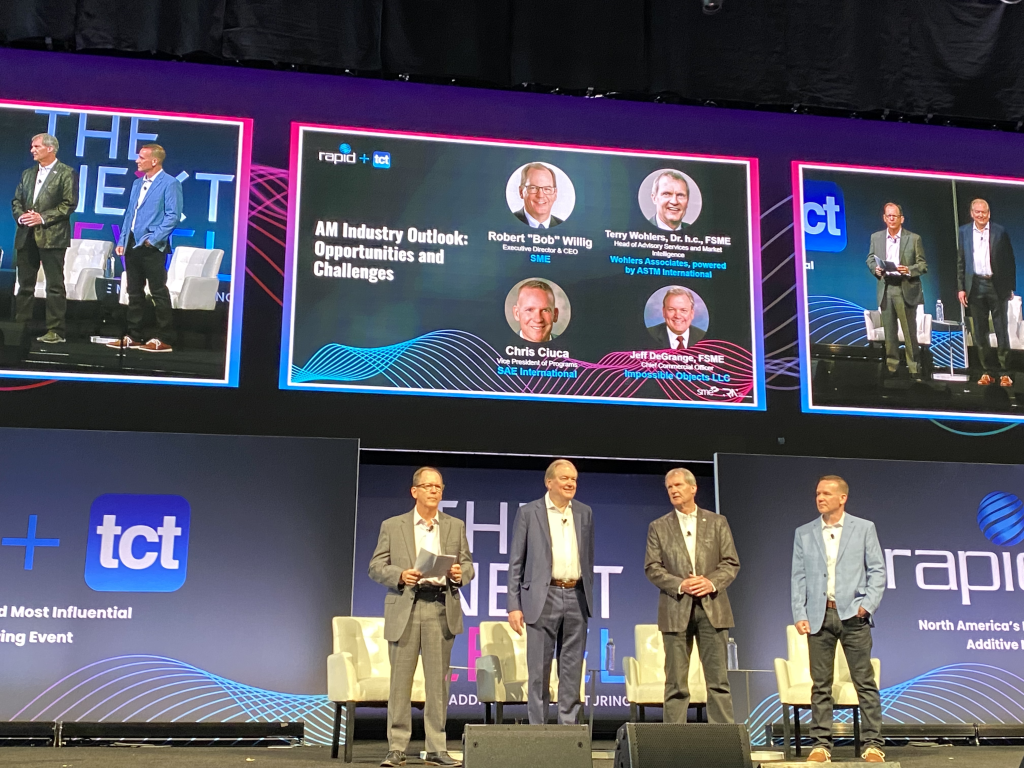
Impossible Objects and ultra fast printing
Following on from an earlier interview, Impossible Objects gave us more information on the CBAM 25. This new 3D printer follows a common theme of this year’s event – optimizing the production process with faster printing speeds.
As previously reported, Impossible Objects says CBAM 25 3D prints 15 times faster than its competitors using Composite Based Additive Manufacturing (CBAM) technology. With a max build volume of 18 x 17.7 x 4 inches, the CBAM 25 can achieve max printing speeds of 25 feet per minute at an accuracy of 125 microns.
“Our process is a big breakthrough on productivity,” company CEO Steve Hoover told 3D Printing Industry. Hoover points to applications such as electronics tooling and commercial drone manufacturing as being well suited to the CBAM 25. Indeed, Hoover attested that a drone that would take four hours to print using the fastest traditional additive methods on the market can now be produced “radically faster” in just five minutes.
According to Hoover, the CBAM 25 has been well received during this year’s event. “People really do get the value of the speed,” commented Hoover. Indeed, Impossible Objects are already receiving orders for their new system, with three customers already having put down deposits since the machines launch.
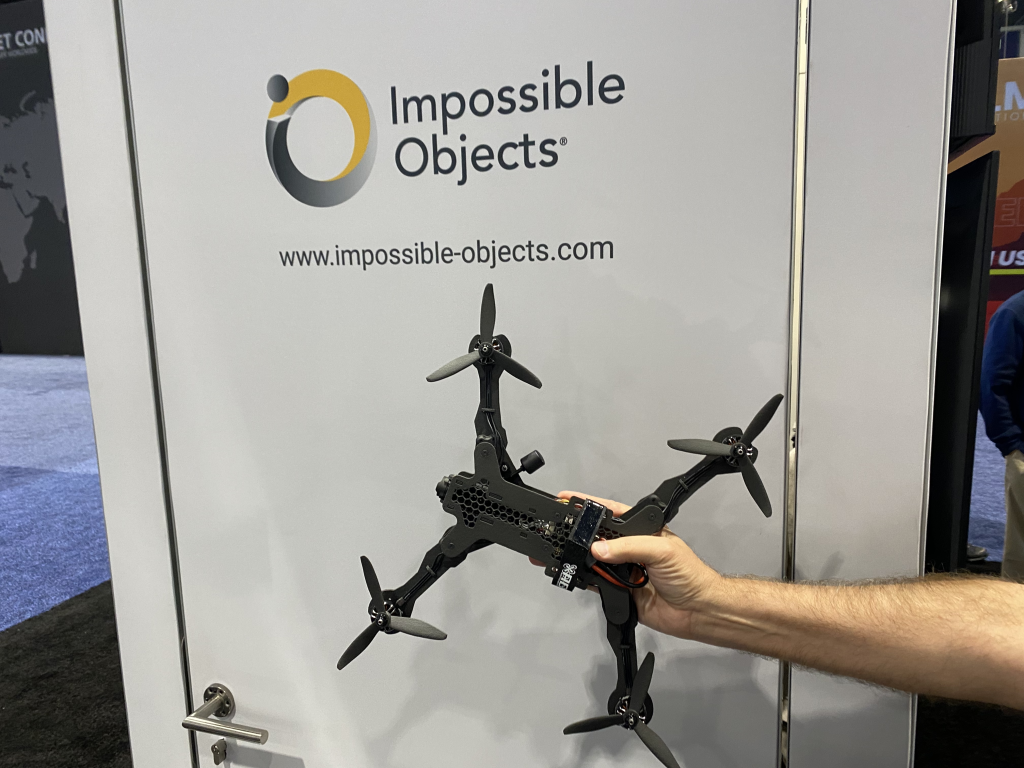
The XSPEE3D
Another new machine offering fast printing speeds is the XSPEE3D by SPEE3D. Offering rapid build rates of up to 100 grams/minute, this new containerized metal 3D printer can print 1,000 times faster than laser based 3D printing methods. These impressive speeds are achievable thanks to SPEE3D’s patented supersonic deposition technology, in which a rocket nozzle accelerates air up to four times the speed of sound, with the resulting kinetic energy causing the powders to bind together and form high-density parts.
Costing around $1.4 million for the hardware, this machine is primarily targeted towards the defense industry, with its 20ft container enclosure being easy to transport, and ruggedized for field deployment. “You can move it just like any other piece of military equipment, stick it on the back of a truck, air lift it, and put it where it needs to be,” commented SPEE3D Chief Revenue Officer Paul Maloney.
In fact the British MOD has already purchased a XSPEE3D system, with the company also working closely with the British Army’s Royal Electrical and Mechanical Engineers to deliver training courses as part of a two-year contract. “The first one’s on the water, and are supposed to be in the UK in probably the late May, early June timeframe”, said Moloney.
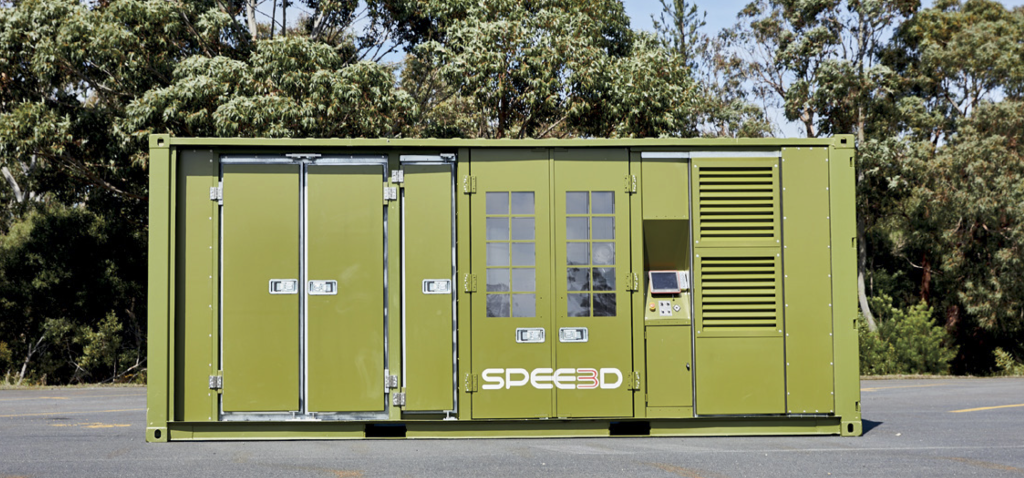
Essentium – showcases parts-on-demand services and HSE 240 HT printer
We also caught up with Essentium, who showcased their recently launched Essentium Parts on Demand (EPOD) service. According to Joe Anguiano, Essentium Director of Sales – EPOD, this is an in-house “parts on demand service” that gives customers the chance to “experience our materials and our fast print speeds.” “It’s mainly geared towards customers that have already made the decision that an additive manufacturing approach is the best way for their particular part in question, and so creating the materials and systems in place to help them scale to those production volumes,” continued Anguiano.
This announcement follows last year’s launch of the HSE 240 HT Dual Extrusion 3D printer. This system, which will become commercially available later this year, is capable of printing at high speeds of up to 375 mm/s, and uses a non-slip, high-torque extrusion system with all linear-servo motors. The 240 HT is also an open material platform, providing customers with more material options and greater flexibility.

Frontier – General Lattices new digital material software
Away from new 3D printing systems, General Lattice have launched Frontier, a new software offering. Designed to democratize the use of lattice structures, this digital library of validated mechanical property data is free-to-access and allows users to search, analyze, and order physical lattice samples. Current partners already include EOS, BASF, and Photocentric, with these companies supplying valuable materials and data to the Frontier platform. Customers that have already shown interest in this new offering include those within the automotive industry. Additionally, according to General Lattice Co-Founer and COO Alex Rhoades, the company has already been receiving a good deal of positive feedback.
Additionally, in September, General Lattice is set to launch an additional integrator tool which will allow users to upload CAD design, and integrate selected materials directly. Not intended to be a full product development tool, this software will be primarily targeted toward aiding customers in the early stages of product development. Unlike Frontier, this tool will require a paid subscription to access.
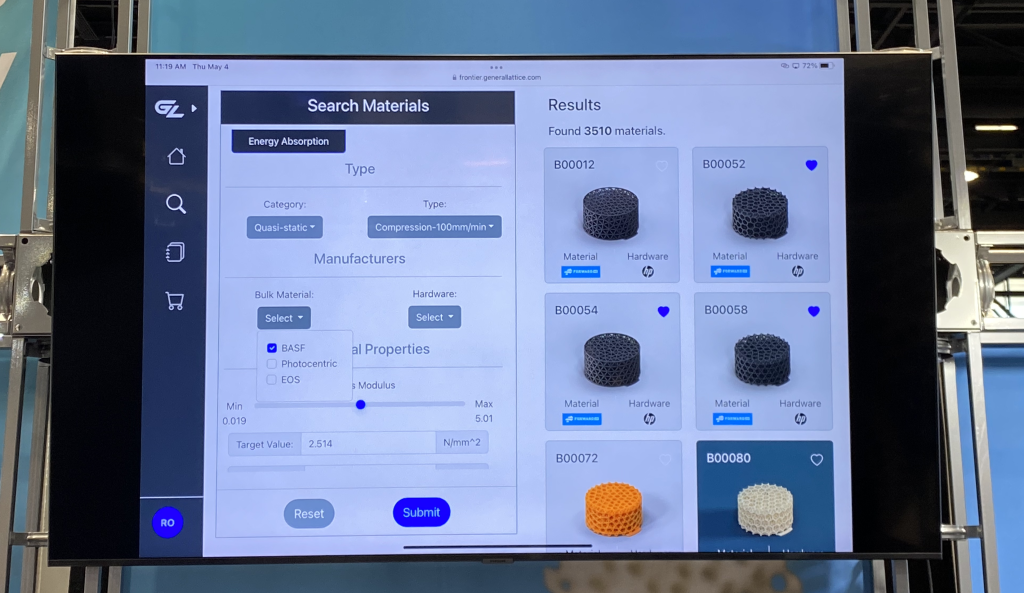
6K Additive and sustainability
Moving onto materials now, 3D Printing Industry caught up with Leslie Frost, 6K Additive’s Senior Director of Marketing, to learn more about the company’s vision for sustainable metal powder and alloy production.
“Sustainability is one of our key foundations,” attested Frost. Indeed, a recent life cycle analysis (LCA) compared 6K’s process with two alternative processes, plasma atomization and gas atomization. The results of this analysis highlighted 6K additive as being 92% more energy efficient in the production of Nickel Alloy 718, “producing less hazardous waste than any of the other competitors out there for nickel.”
Furthermore, the company also works to recycle scrap metal to produce new materials, providing further sustainability to their business model. In fact, the company has just announced an agreement with Australian-based Surgical Metal Recycling (SMR). Through this partnership, 6K Additive takes end of life surgical implants, and reprocesses them into new titanium powder to then make new implants. 6K Additive will utilize its UniMelt production-scale microwave plasma platform to achieve this. Ultimately, Frost characterizes 6K Additives as providing an “incredibly sustainable and circular supply chain.”
Want to catch on all the news from the largest 3D printing event in North America? Follow the links below:
Day One 3D printing news from RAPID+TCT 2023
Day Two 3D printing news from RAPID+TCT 2023
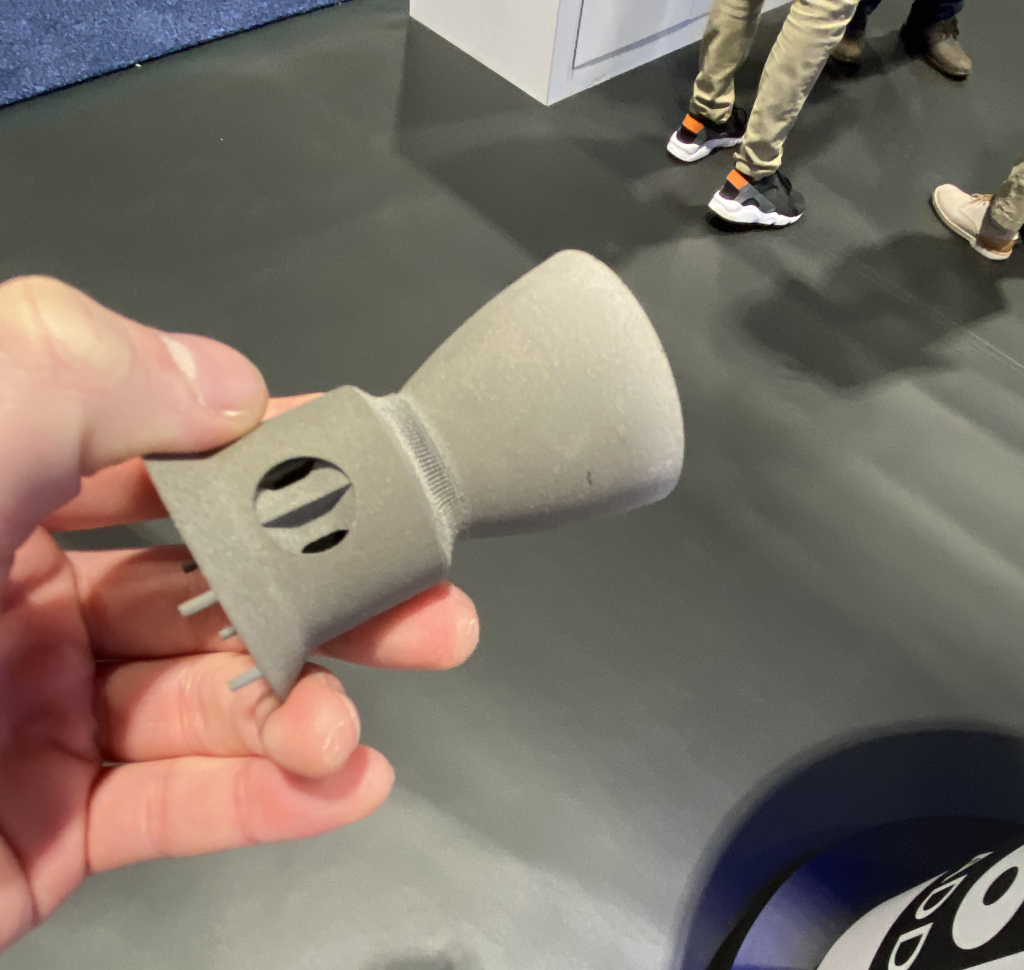
Subscribe to the 3D Printing Industry newsletter to ensure you keep up with the latest 3D printing news. You can also follow us on Twitter, like our Facebook page, and subscribe to the 3D Printing Industry Youtube channel to access more exclusive content.
Are you interested in working in the additive manufacturing industry? Visit 3D Printing Jobs to view a selection of available roles and kickstart your career.
Featured image shows the show floor on day 3 of RAPID + TCT 2023. Photo by 3D Printing Industry.


